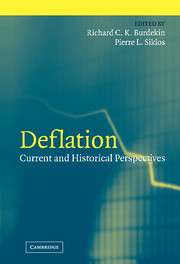Book contents
- Frontmatter
- Contents
- List of Tables and Figures
- List of Contributors
- Preface
- 1 Fears of Deflation and the Role of Monetary Policy: Some Lessons and an Overview
- PART ONE FEARS OF DEFLATION AND THE ROLE OF MONETARY POLICY
- PART TWO DEFLATION AND ASSET PRICES
- PART THREE INTERNATIONAL PERSPECTIVES ON DEFLATION
- 7 Is Deflation Depressing? Evidence From the Classical Gold Standard
- 8 The Strong Lira Policy and Deflation in Italy's Interwar Period
- 9 Deflation and Stagnation in Japan: Collapse of the Monetary Transmission Mechanism and Echo From the 1930s
- PART FOUR STOCK MARKET ADJUSTMENTS TO DEFLATION
- References
- Index
- Titles in the series
9 - Deflation and Stagnation in Japan: Collapse of the Monetary Transmission Mechanism and Echo From the 1930s
Published online by Cambridge University Press: 15 December 2009
- Frontmatter
- Contents
- List of Tables and Figures
- List of Contributors
- Preface
- 1 Fears of Deflation and the Role of Monetary Policy: Some Lessons and an Overview
- PART ONE FEARS OF DEFLATION AND THE ROLE OF MONETARY POLICY
- PART TWO DEFLATION AND ASSET PRICES
- PART THREE INTERNATIONAL PERSPECTIVES ON DEFLATION
- 7 Is Deflation Depressing? Evidence From the Classical Gold Standard
- 8 The Strong Lira Policy and Deflation in Italy's Interwar Period
- 9 Deflation and Stagnation in Japan: Collapse of the Monetary Transmission Mechanism and Echo From the 1930s
- PART FOUR STOCK MARKET ADJUSTMENTS TO DEFLATION
- References
- Index
- Titles in the series
Summary
INTRODUCTION
On February 13, 2002, Japanese Prime Minister Koizumi directed ministries to formulate emergency countermeasures to deflation, stating, in a press release that “while deflation has a varied background, the resolution of the immediate financial problems is indispensable to overcoming deflation” (italics added). Koizumi linked deflation, shown in Figure 9.1, to banking problems and a credit crunch, and called on the Bank of Japan to take action. The same press release goes on to state, “In particular, with regard to the disposal of non-performing loans which presently stands as a top-priority issue, actions shall be taken to achieve concrete progress in line with the ongoing process of special inspections, thereby solidifying the prospects for an early resolution of the so-called ‘non-performing loans problem.’ Meanwhile, the government shall stand ready to take any and all necessary measures to prevent a financial crisis. Overcoming deflation will require the government and the Bank of Japan to act in unison. Therefore, we turn to the Bank of Japan with the request that it act with due audacity in implementing monetary policy” (italics added; Japan Ministry of Foreign Affairs 2002).
The call by the Prime Minister for the government to take emergency action reflects the concern that the deflation in Japan, if allowed to persist, would gradually erode the foundation of the economy and eventually lead to a much deeper and dramatic decline reminiscent of the Great Depression in the 1930s. Initially viewed by policy makers as a “good deflation,” price declines were now seen as a harbinger of economic collapse.
- Type
- Chapter
- Information
- DeflationCurrent and Historical Perspectives, pp. 241 - 268Publisher: Cambridge University PressPrint publication year: 2004
- 2
- Cited by



